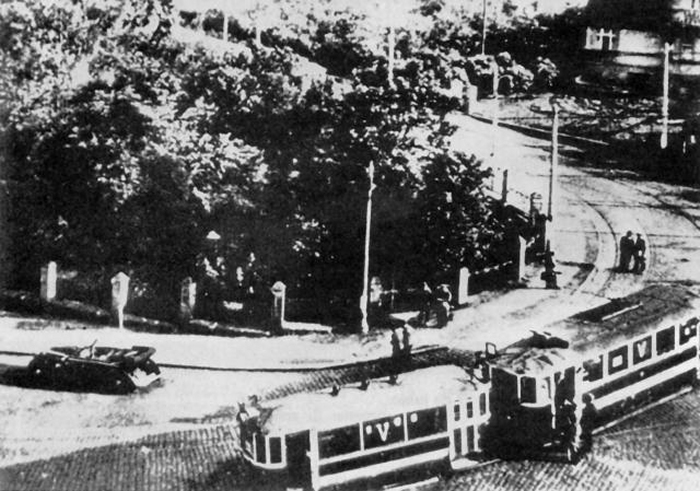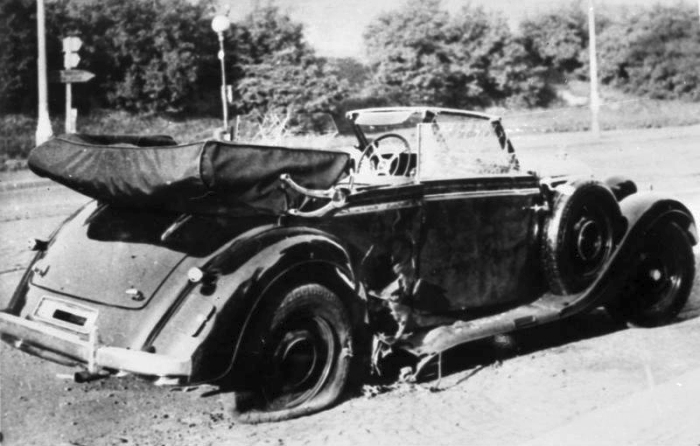![]()
The Charlotte News
Wednesday, May 27, 1942
FOUR EDITORIALS
![]()
![]()
Site Ed. Note: First, we make a correction to the note of last Saturday: the mural by Diego Rivera, "The Bandit Hero", while commissioned and finished in 1936 for Hotel Reforma, was, along with the other three murals so painted, taken down and stored for twenty years after the owner had them doctored to remove some controversial political elements which he felt would offend his American tourist trade and the militarists within the government. Rivera objected, sued, and the murals were removed. Thus, "The Bandit Hero" actually was not present in the hotel on July 1, 1941.
But, was the spirit of that painting still extant? If so, which way did it slice? How far ‘round did the circle go?
The front page reports from Lithuania that 400 Poles and Lithuanians were executed in reprisal for the killing of two German civilians "rebuilding Lithuania", an example of the typical Nazi response to deter resistance in occupied countries.
Another story tells of the wounding this date in Prague of Reinhard Heydrich, the "protector" of Bohemia and Moravia. Worries were that Czechs would be rounded up wholesale and slaughtered en masse as the Nazis threatened reprisal by execution against anyone harboring the fugitive assailants.
Heydrich would die on June 4. In response, some 13,000 Czechs and Slovaks were rounded up and either imprisoned, deported, or executed.
He had been the leader of the infamous Wannsee Conference, held January 20, 1942 in the suburb of Berlin, at which the Final Solution to the "Jewish Problem" was developed. It consisted of "evacuating" to the East, into Russia and Poland, the remaining Jews in Central Europe, using the fit as road-builders and laborers until they died from exhaustion, and then quietly exterminating the rest, per Hitler’s decision in the fall of 1941. Estimates were that eleven million Jews remained in Europe, two million of whom were in unoccupied countries. By the end of the war, six million of the remaining nine million were murdered by the Nazis.
Although not per se for his role at Wannsee, he was deliberately targeted for his prominence in the Gestapo. During the fall of 1941, British intelligence trained two men, Jozef Gabčik and Jan Kubiš, to carry out the killing.
The attack occurred while Heydrich was being driven through Prague in his open Mercedes-Benz convertible, on his way to visit Hitler in Berlin. In the Prague suburb of Kobylisy, the two men hid in the arc of a long U-curve at which Heydrich’s car had to slow to enable the turn where the Prague-Dresden road merged with the Troja Bridge road. Gabčik attempted to fire on Heydrich with a sub-machine gun. When it jammed, Kubiš threw a bomb at the right rear of the car, wounding Heydrich.
Although of doubtful authenticity, a report stated that Heydrich emerged from the car with his pistol drawn and gave chase until he fell into shock from his wounds.
The apparently slight resultant injury, thought to be the case after the incident, gave way on June 2 to grave illness when, curiously, he suddenly slipped into a coma from which he never emerged after a visit from Heinrich Himmler, his boss in the Gestapo. Perhaps, Heydrich was more valuable to the Reich as a dead lion than a live wolf by this point. Nevertheless, officially, he died of blood poisoning, in complication from his wounds.
Heydrich had made his mark in the Reich from within the Gestapo, having directed its role and that of the S.S. in the infamous Kristallnacht, November 9 and 10, 1938, among his other strategic efforts aimed at harassing or eliminating the Jews from Europe.
He was buried in a cemetery which crossed the eventual post-war boundary region between East and West Berlin. Although Hitler had planned to erect a large tomb to him, the former's own demise ended the Heydrich Memorial short of realization; the wooden marker on his grave disappeared after the war and his actual gravesite is unmarked, unknown, and forever consigned to the depths of darkest hell, along with his bosses and other pals.
But, given the manner of the attack on his life, at that long, slow curve, and given that he became a martyr for the Reich, with his grave between East and West Berlin in the post-war era, did his attack serve as a blueprint for Dallas—by way of getting even? By hardcore anti-Communist Birchers and Kluckers who had served the purposes of the Reich, either as part of it in fact, or in America as part of the Bund, Silver Shirts, Christian Front, Committee of One Hundred, or similar isolationist causes during the pre-Pearl Harbor days, the most hard-bitten remaining so afterward, stuck in that xenophobic urge to will against the Other down to the crack of doom, carrying over into a coalescing partnership between those actively resistant to the Civil Rights Movement and those bitterly believing the Kennedy Administration had appeased the Soviets during the Cuban Missile Crisis, and that the President was thus the Dixonesque "Traitor"?
On October 10, 1941, Heydrich had also conducted a conference in Prague at which the proposal was made to move the 50,000 Jews in Bohemia and Moravia into Soviet territory at Riga and Minsk.

The Heydrich Curve

The Heydrich Mercedes-Benz
And remember that Herblock cartoon of a few months earlier. And, this one, as well.
Nor forget that Hertz jingle from 1963, which we all remember.
Elsewhere on the front page, speculation was running rampant that a high level conference of Allied commanders in London was for the planning of more intense air raids to precede a full scale AEF landing in German-occupied territory in Europe, i.e., probably in France or Norway. It was of course still two years away.
What they were planning was the overall strategy of the war. But first a landing had to be made in North Africa, to cut off the Mediterranean to the Axis and prevent thereby a naval and air flanking maneuver which would distract Allied forces to that theater rather than enabling full concentration of forces on the bottle-up in Central Europe. As mentioned yesterday and as pictured today, Major-General Dwight D. Eisenhower was among the brass present at the meeting.
And on the editorial page, a gentleman from the Department of Religion at Morris College in South Carolina writes eloquently of the spiritual and ethical darkness ushered into South Carolina by the actions of the Union County Democrats in denying party membership to African-Americans with the goal of denying their right to vote. He cautions against resort, in rationalizing this denial of the right to vote, to the argument rested on Reconstruction experience, the argument typically being that, given ostensible equality of rights, the black man "took over" in the South during this post-Civil War period, an argument heard in the South well into the 1960’s. "Give them an inch and they’ll take a mile," was the oft-heard refrain.
But you cannot possibly have worry about a minority group having a mile in society when the rest of the society has ten, and usually of more prosperous plenty.
The writer recommends reading, contra this notion of Reconstruction paranoia, W.E.B. DuBois’s Black Reconstruction. Unfortunately, we have been able to locate online for you only the first chapter.
![]()
![]()